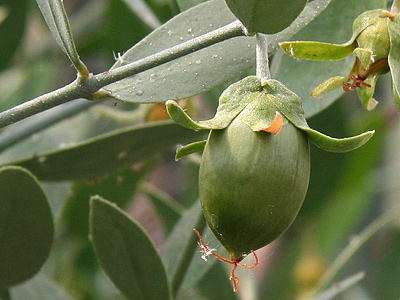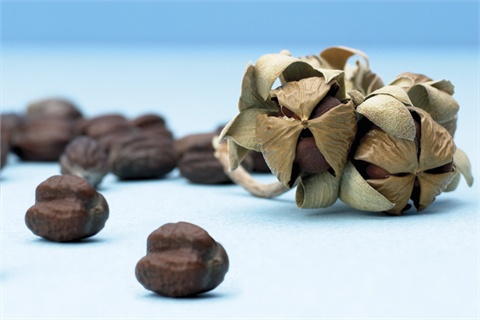Simmondsia Chinensis
Yield
Because jojoba has never been grown commercially, there is little data available on cost of production, yields of seed and wax, market demand, and pricing. The absence of such basic data does deter establishing large commercial plantations, but preliminary production and marketing data, collected for 10 years, give some of its agronomic aspects leading to optimism about jojoba’s economic potential.
A yield of 3,000 pounds of seed per acre (3500 kg/ha) from a 9- to 10-year-old plantation appears to be a realistic expectation. A price of $2 per pound of oil ($4.4/kg) could also be realized in the beginning for low-volume, high-priced products. A progressive long range dropping to $1 per pound ($2.2/kg) may be necessary for the oil to ensure a larger market for low-priced, high volume products; at that price it would compete successfully with other lubricants.
Seed yields in natural populations range from a few seeds to more than 30 pounds (14 kg) of clean dry seed per plant. The high yields have been recorded on plants approximately 15 feet (5 m) tall with as large a diameter, following warm and wet years. These high yields were observed on a small number of plants and in certain years only. The mean yield of several hundred wild plants harvested in California over a period of 5 years was about 4 pounds (1.8 kg). The average height of these plants was about 6 feet (2.7 m) and the diameter 5 feet (2.3 m).
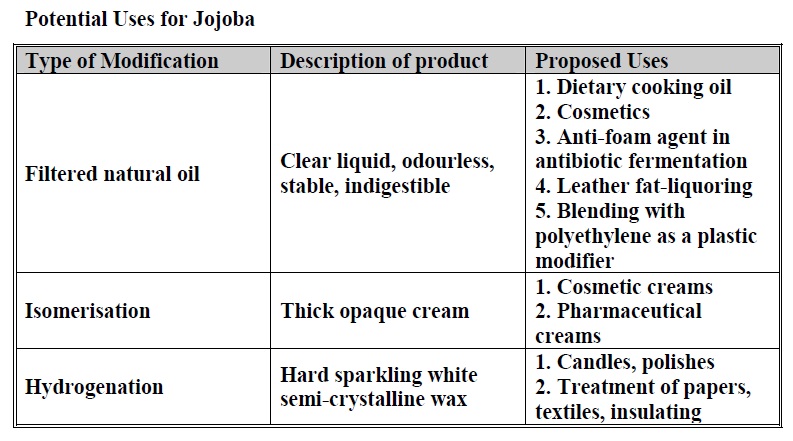
A 5-acre (2 ha) cultivated jojoba plot with rows 10 feet (3.3 m) apart and plants 5 feet (1.5 m) apart on the row, the average yield of the best strain was 350 pounds per acre (400 kg/ha). Some plants exceeded 1 pound (450 g) per plant.
The average harvested yield for 1987 was about 130 kg/ha from vegetatively-propagated fields, and 92 kg/ha from seed-planted fields. Most of the vegetatively propagated fields had not reached their maximum potential at that time. Some individual growers reported up to 800 kg/ha from their small-scale upgraded seeded fields, and up to 2,000 kg/ha from their vegetatively propagated experimental plots. These were exceptions, rather than the rule.
The total area covered by the crop throughout the world is currently around 8,500ha. In 1999-2001 Israel produced one third of the world production of jojoba, average yields are around 3.5 tonnes/ha (potential yield is 4.5 tonnes/ha), this is relatively high compared with production potential in Argentina and the USA. World demand is currently estimated at between 64,000 and 200,000 tonnes/year.
Oil Content
The oil content of the seed of both cultivated and wild plants has been about 52% with a range extending from 44 to 59%.
Unrefined jojoba oil appears as a clear golden liquid at room temperature with a slightly fatty odor.
The oil or liquid wax extracted from jojoba (50% by weight wax in seed) is a unique unsaturated oil composed of non-glyceride esters consisting almost entirely of straight-chain acids and alcohols. These compounds are difficult to synthesize commercially and the only other source is the sperm whale.
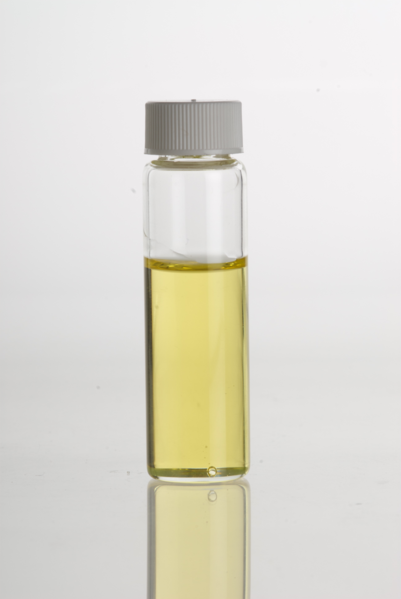
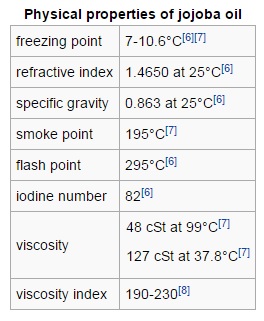
Uses
Jojoba oil is found as an additive in many cosmetic products, especially those marketed as being made from natural ingredients. In particular, such products commonly containing jojoba are lotions and moisturizers, hair shampoos and conditioners. Jojoba esters are mainly used as emollients in cosmetics such as lipsticks, shampoos and moisturizing lotions.
The cosmetic industry appears to be the principal market for jojoba oil products, around 2,000 tonnes per year are thought to be utilized by this industry, this equates to almost 80% of the total market share. The other major industry using jojoba oil is the pharmaceutical sector.
Description
Jojoba grows, to 1–2 meters (3.3–6.6 ft) tall, with a broad, dense crown, but there have been reports of plants as tall as 3 meters (9.8 ft).
Plants do not begin to fruit until about five years after establishment, and full potential isn’t reached until 8-10 years after planting.
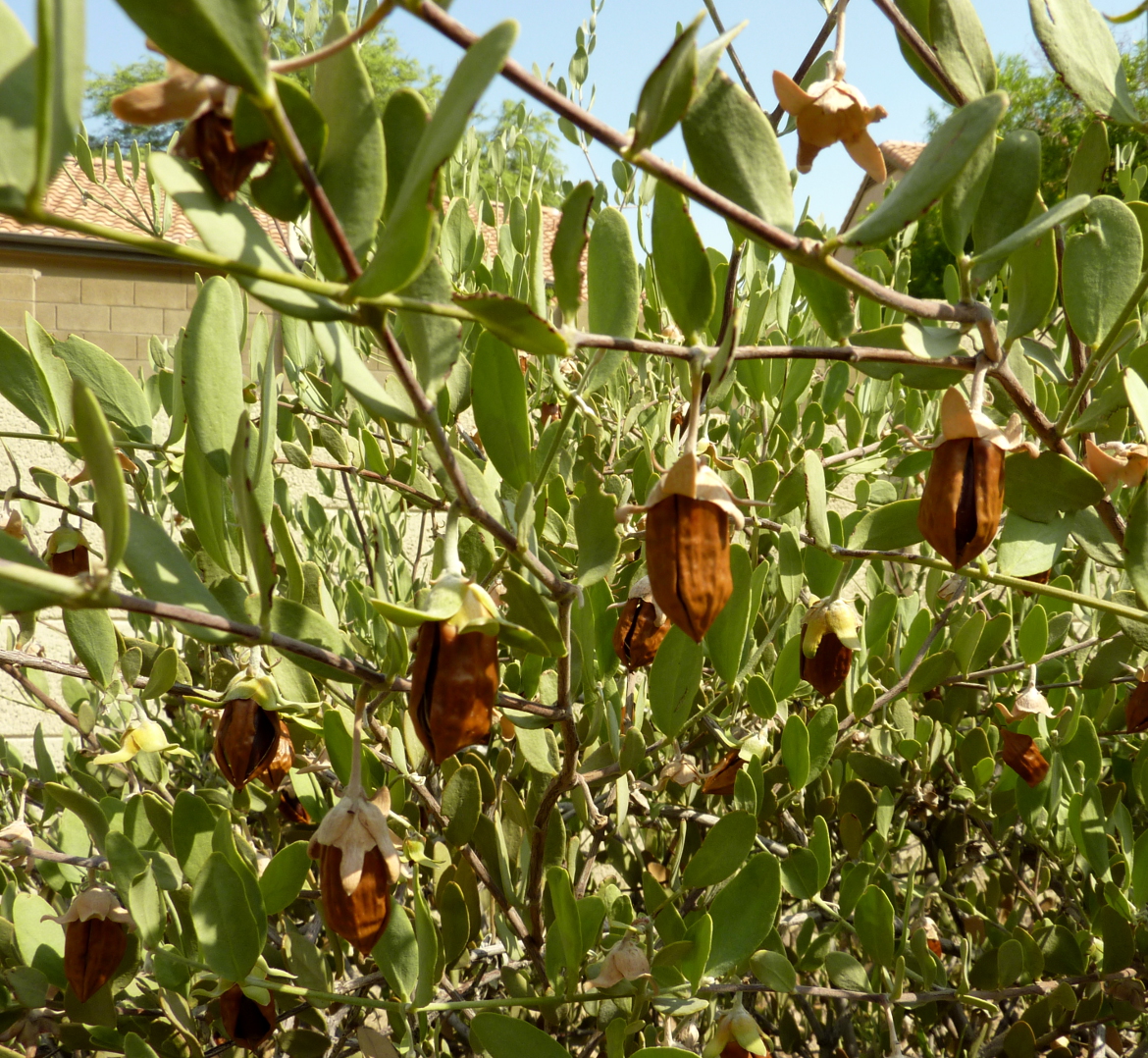
Distribution
Robust jojoba plants grow as close as 10 feet (3.3 m) from the ocean. Further verification of jojoba's salt tolerance has been offered by greenhouse experiments and by experimental field irrigations with brackish water.
Jojoba is endemic to Northern America and occupies an area of approximately 260,000 square kilometers (100,000 sq mi) between latitudes 25° and 31° North and between longitudes 109° and 117° West, Natural populations occur between 23 ’ and 35 ’ north latitude and can be exposed to temperatures between -9°C and 50°C. Areas in Spain and Portugal have also been cultivated.
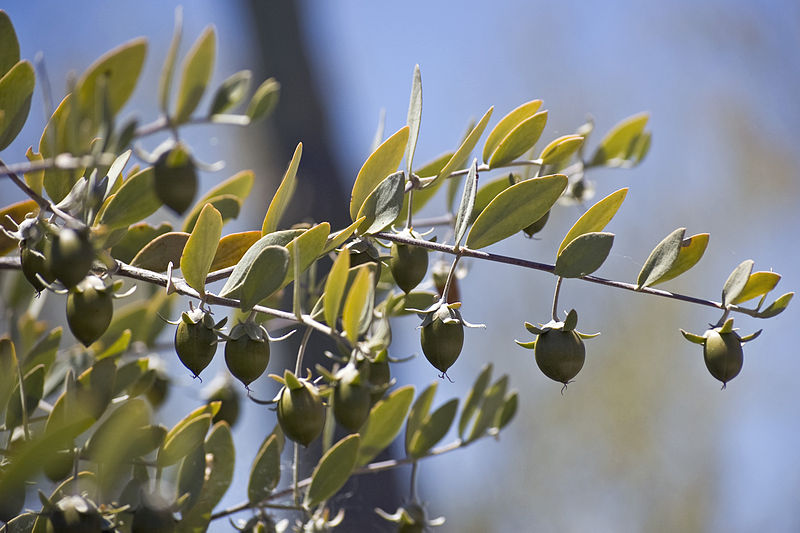
Planting
Populations occur on coarse, light or medium textured soils with good drainage and good water penetration. Experimental plantings established on heavy soil bloomed much later and grew slower than did those on light soils. It tolerates salinity and poor-nutrient soils. pH should be between 5 and 8.
When temperatures reach 20- 22 F (-6 to -5 C), flowers and terminal portions of young branches of most jojoba plants are damaged. During early seedling development, excessive cold may kill entire plantations. As plants grow taller, frost may not endanger their survival to the same degree but it may curtail yields. In this regard, frost damage in the early flowering stages may not be as destructive as at later stages.
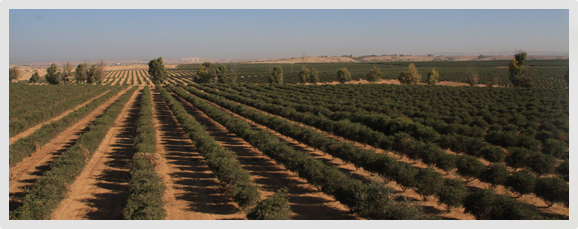
Jojoba Plantation Israel
High temperatures do not have adverse effects unless they exceed 122 F (50 C).
Jojoba may be propagated through seed, rooted cuttings, and tissue culture. Present sources of seed are the natural populations. No Hybrid species exist.
During the first 10 years and under favorable soil and climatological conditions in California, jojoba grows 1/2 to one foot (15 to 30 cm) per year in diameter and in height. Under warmer conditions, this growth rate may double.
The ratio of male to female plants that should be expected in commercial plantings is about 1:l or slightly in favor of males by about 5 percent. Crowding of plants does not seem to depress plant growth and production.
Individual seeds or seedlings are planted 1 to 1 1/2 feet (30 to 45 cm) apart. Planting plans involve overplanting initially; as much as 7 to 9 pounds of seeds per acre (6 to 8 kg per hectare) may be needed. Overplanting is recommended, however, because it enables a grower to adjust the density and pattern of males in his field, to eliminate low-producing females and to maximize yield per acre.
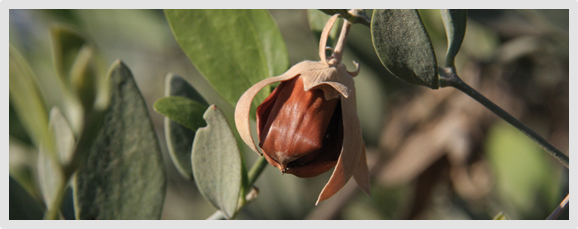
For faster emergence, plantings should be made during the warm months of the year and depth of planting should not exceed 1 1/2 inches (2 to 3 cm), with soil temperatures of 70° F (21°C) or higher.
Jojoba can be seeded or transplanted to the field when the soil temperature reaches 70°F. Low soil temperature may delay emergence by as much as 2 to 3 months.
Direct Seeding
Most of the direct seeded commercial jojoba fields were planted with commercially available planters on raised beds. With two planters mounted on a tool bar, one tractor operator can plant 60 acres a day. Larger seeds are easier to harvest and usually with a higher wax content and are also preferred in planting because they are likely to produce large-seeded plants. Large seed produces more vigorous seedlings than small seed during the first 2 to 3 months of growth; however, this superiority disappears later.
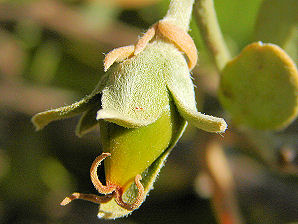
Seeds are planted 1 inch (2.5 cm) deep, and emergence usually occurs within 20 days. The soil should be kept moist but not wet through emergence. Individual seeds or seedlings are planted 12 to 18 inches apart in rows. Spacing between rows depends on the harvester to be used. With hand harvesting and cultivation, rows can be as close as 10 ft.
Low soil temperature may delay emergence by 2 to 3 months. Irrigation should be applied as needed during the first 2 to 3 months to maintain adequate moisture near to the surface of the raised bed to insure good germination and root establishment.
Seed Description
Jojoba Seed (Nuts) have an oblong to oval seed produced by the female jojoba plant weighing 0.2 – 1.5 grams each with a diameter of 3-15 mm and which at maturity is reddish brown with a wrinkled surface. Mature jojoba seeds contain approximately 3% moisture, 15% protein, 42% to 58% liquid wax esters, 5% to 7% simmondsin and the balance carbohydrate and fiber.
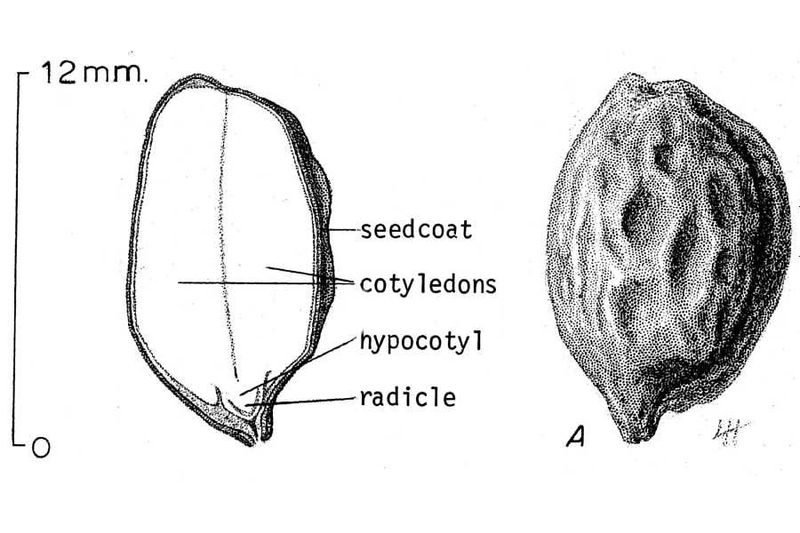
The fruit is a green capsule which encloses up to three seeds. When ripe (3 to 6 months after fertilization) the capsule splits and reveals the seed, which is brown, wrinkled and about the size of a small olive (300 to 1,000 seeds/lb). Seed production is generally limited until the fourth year of growth.
Harvesting
With hand harvesting and cultivation, rows could be as close as 10 feet (3.3 m) apart. In mechanized farms space should be allowed between rows for vehicular traffic with optimum spacing closer to 14 to 16 feet (4 to 5 m).
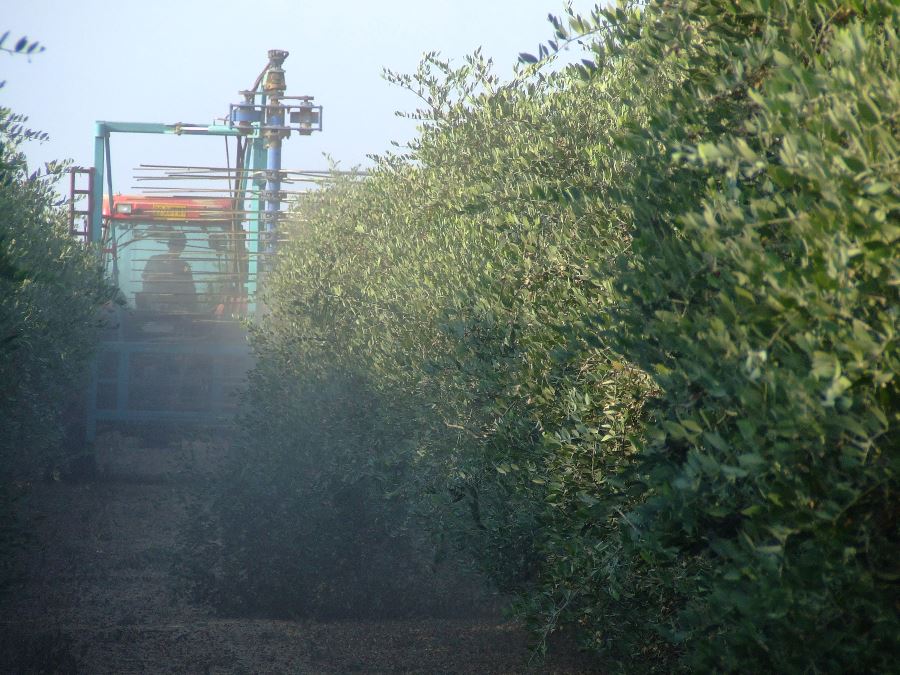
Pruning
It may be unnecessary to allow plants to grow any taller or wider than 10 to 15 feet (3 to 5 m). This decision, however, will have to wait until yield data from various types of 10- to 20-year-old hedgerows are available.
Plants are allowed to grow naturally for about three years. After thinning is completed, the rows are pruned vertically with the kind of cane cutter used in vineyards.
Disease
On poorly drained soil, jojoba is susceptible to fungal wilts, including Verticillium, Fusarium, Pithium and Phytopthora.
Irrigation
Natural jojoba populations grow in areas receiving 3 to 18 inches (76 to 450 mm) of precipitation annually. The best jojoba plants observed so far, 15 feet (5 m) in height, were in areas with 10 to 15 inches (254 to 380 mm) of annual rain.
Jojoba utilizes most water during late winter and spring and thus does not com- Pete for water with traditional irrigated crops. Supplemental irrigation could maximize production if there is not enough rainfall of 400 mm.
Drainage is critical as well as adequate water supply (400-700mm +/annum) to produce reasonable seed yields.
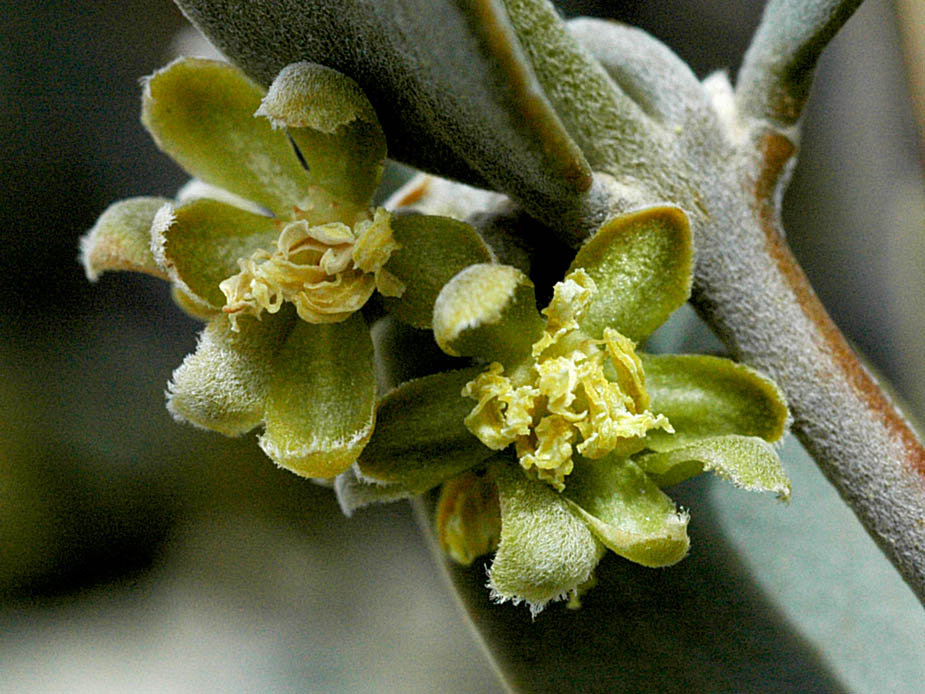
Fertilizer
Not afflicted yet by major diseases or insect pests, and it can withstand many chemical sprays. Jojoba grows naturally on soils of marginal soil fertility. Fertilization of field plots at UCR with nitrogen and phosphorus for three consecutive years (50 pounds of nitrogen, 50 pounds of phosphorus, or 50 + 50 pounds of nitrogen and phosphorus per acre annually) soils should have a pH of 6 or more and available K levels of at least 100 ppm.
Apply enough dolomitic lime according to soil test recommendations to raise soil pH to 6. Approximately 10 to 15 pounds of potash fertilizer should be applied if available K levels are less than 100 ppm. Yield trials conducted in California have not shown any improvement in vegetative growth with the addition of nitrogen or phosphorus, therefore no additional N or P2O5 fertilizers are recommended.
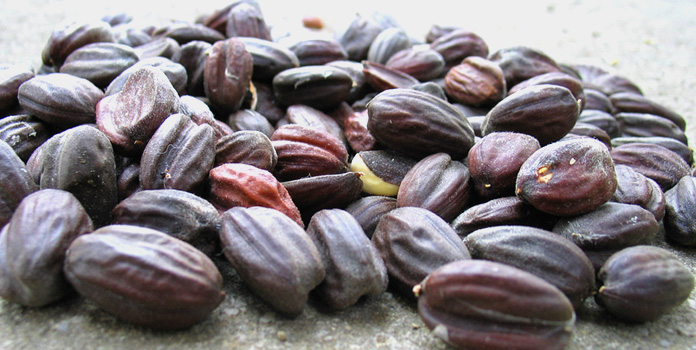
Harvesting
Pressed Jojoba Oil which has been removed from jojoba seed by passing the seed through mechanical presses known as "expellers". These machines "expel" the oil from jojoba seed through the application of pressure, and sometimes heat to facilitate release of the oil from the seed. In addition to jojoba oil, the processing of jojoba seed with expeller presses results in the formation of a jojoba "press cake".
This press cake typically contains 12% – 18% residual jojoba oil, 5-8% moisture, 20-25% protein, 10-12% simmondsin and the balance carbohydrate and fiber and can be pressed a second time. Press cake resulting from this second mechanical press of jojoba seed usually contains 8-10% residual jojoba oil, 4-6% moisture, 22-28% protein, 12% simmondsin and the balance carbohydrate and fiber.
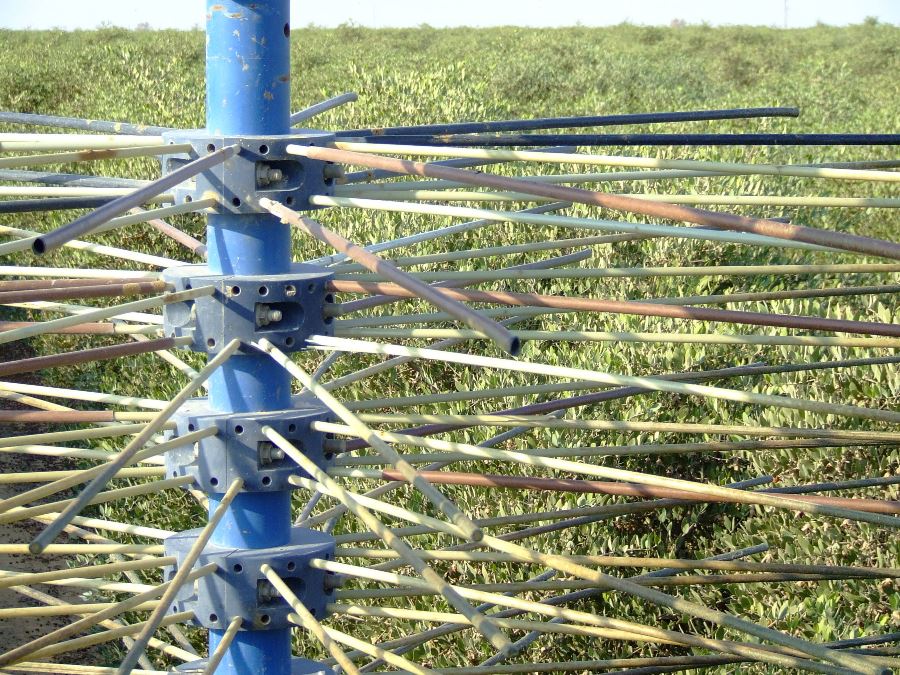
Jojoba seeds are unique in that they contain an actual wax, not oil. From this wax, oils can be expressed or extracted by solvents. The oil is highly-stable, and it has very similar qualities to sperm whale oil, which was used extensively around the world until the middle of the 20th century.
Profit Viability
According to Harington (1987), and McKay (1987), plantation establishments were initiated in 1978. By 1982, it reached about 8,000 ha, hit a peak of about 16,000 ha in 1985 and leveled off.
The first harvest from these commercial plantations was made in 1982. Seed harvests continued as approximately 50 tons in 1823,200 tons in 1984,120 tons in 1985,470 tons in 1986, 500 tons in 1987, and over 1,000 tons harvested in 1988. Jojoba seed prices have also been fluctuating during the past few years (Watson, 1987). Seed were sold for about $3.00 per kg in 1976, continuously rose to over $10.00 per kg in 1981, and gradually declined to about $3.50 per kg in 1987.
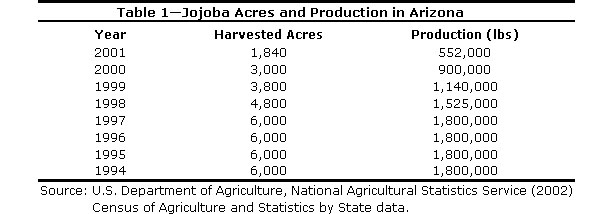
David DuByne is a consultant for companies entering Myanmar & agricultural commodities export broker for green coffee, honey, farm raised fish out of Myanmar. He can be reached at ddubyne (at) oilseedcrops [dot] org.

